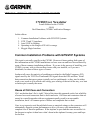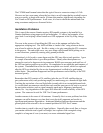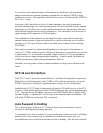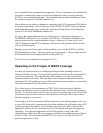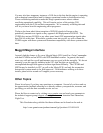You can also verify the performance of the antenna by checking it with an antenna
analyzer that measures antenna impedance through the coax and the VSWR (voltage
standing wave ratio). The impedance should be very close to 50 ohms and the VSWR in
the 2:1 to 3:1 range.
If any part of this chain fails to show a 50 ohm impedance due to bad connections,
incorrect antenna length, etc., the maximum power will not be radiated from the antenna.
Instead part (or all) of the wave is reflected back down the line. The amount of the wave
reflected back depends on how bad the mismatch is. The same can be said for received
signals during an ILS approach or VOR navigation.
The combination of the original wave traveling down the coaxial cable (towards the
antenna during transmit or opposite during receive) and the reflecting wave is called a
standing wave. The ratio of the two above described waves is known as the Standing
Wave Ratio.
The result is presented as a figure describing the power absorption of the antenna. A
value of 2:1 VSWR, which is equal to 90% power absorption, is considered very good for
a small antenna: 3:1 is considered acceptable, which is equal to 75% power absorption
which for aviation is approaching marginal capability. From this point, the higher the
VSWR ratio the more rapidly antenna performance falls off.
Hopefully reviewing some of these common problems will help you avoid them in the
future.
GTX 32 and 33 Interface
The GTX 32 and 33 are remote mounted Mode C and Mode S transponders respectively.
Both of these will be integrated to the CNX80 in V2.0 software and can be used as the
SL70R is used today, allowing for significant space savings in your cockpit panel.
In addition the GTX 33 Mode S transponder will provide TIS traffic service as the GTX
330 does, which will be displayed on the CNX80 traffic page that will be implemented in
V2.0. You may also tie this traffic source into your MX20 and be able to display traffic
on either display. A separate STC will be done to accommodate these installations. We
will notify CNX80 users when this STC is complete.
Auto Suspend In Holding
We’ve found a minor problem in V1.x software that occurs occasionally in course
reversals in a holding pattern during approach.
As mentioned in our first newsletter, if you are performing a course reversal in a holding
pattern in lieu of a procedure turn, the database is constructed in such a way as to
accomplish the course reversal and perform one turn in holding. This allows for altitude



